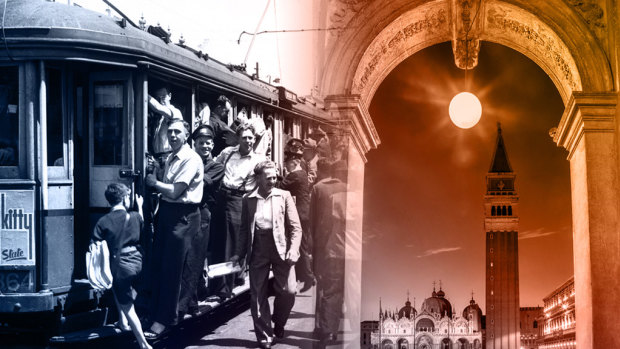This was published 5 months ago
Opinion
Sydney’s surprise resemblance to Venice has a lesson for us all
Antone Martinho-Truswell
Zoologist and evolutionary biologistSydney can feel so Italian. No, not Italian. There is no “Italian”. Sydney feels Venetian.
The two cities share far more than the maritime culture of their dense and frightfully expensive centres. Both are characterised by radiating support structures, out of site and mind to the tourists. They have their less glamorous second centres, modern cities where real work can be done (Mestre/Parramatta), connected to the old city by a hated thoroughfare (Ponté della Libertá/Parramatta Road).

History worth reviving: the tram on Parramatta Road, Leichhardt, in 1946 and Venice’s famed bell tower, the Campanile of St Mark, which collapsed in 1902 but was rebuilt by 1912.Credit: F Burke, Alamy
They have their ports and airports neatly sequestered away from the heritage cores (Marghera, Botany). They both have their little almost-twins tucked away down south (Chioggia, Sutherland Shire). Both their outskirts are filled with a frustrated generation, nursed on stories of an easy life of salt and sun at one’s doorstep, now a long and exhausting commute away, and swarmed with a new global culture they do not remember from childhood. Both are threatened by the development and crowding brought on by their profound attractiveness to foreigners. That attraction is born of isolation, a whole world crowding in to see the beauty of a once far-away place over the sea.
This is all very romantic, but is it useful? Is there anything to be learned from an ancient floating city that, in truth, is like no other at all. One whose mailboats and canal dredging and gondoliers must have little applicability to any other land-bound city? While Venice’s infrastructure is sui generis, there is an idea that Sydney sorely lacks. It was born in Venice in response to a tragedy not unlike one Sydney has yet to address.
In the middle of the last century, after strategic neglect throughout World War II, Sydney ripped up its tram network. Maybe you are aware of this – there are little remnants to be seen in the Forest Lodge Tramsheds, the occasional bit of visible track, and the still-idiomatic “man on the Bondi tram”. But I think most of us do not see the whole tragedy. Have a Google of the full extent of the Sydney trams in 1950. Find the amateur maps made to show the full network and wonder at the extent of it. Then weep.
The reason you have to find amateur maps on Google is that the Sydney tram network was not just removed – it was expunged. Consciously and with malice. Much has been written about this that I won’t rehash, but stories of tracks filled with tar the day after a line closed and power lines ripped out to prevent communities lobbying for reinstatement reflect the deliberateness with which the city’s leaders, in thrall to the automobile, vandalised our community infrastructure.
In 1902, Venice’s famed Campanile of St Mark collapsed into rubble in the piazza below. Termed the “Father of the House” for its height and symbolic power, the bell tower had stood for more than 400 years. This was not a conscious vandalism, though it was exacerbated by mild mismanagement of maintenance and restoration works in the preceding decades. Not unlike in Sydney, the modernisers smelt blood and attacked, with some suggesting the piazza was better without the tower, and denouncing a reconstruction as kitsch and historically invalid. When Filippo Marinetti – fascist, futurist and poet – published his manifesto for demolishing Venice, filling in the canals, and building a militarised port in 1910, he scattered the copies from the top of the partly reconstructed campanile he so despised.
But despite the detractors, a very Venetian idea won the day: dov’era e com’era (Venetian for “where it was and how it was”). This was the sentiment that guided the reconstruction, and the campanile we see today is as close a clone to the fallen one as could be accomplished. By 1912, things were back as they should be.
In the last local elections, Sydney Lord Mayor Clover Moore spruiked an idea to repair our despised thoroughfare, Parramatta Road, with a new light rail line down the centre. This brought on the usual squawking from the very modern naysayers who lament the loss of a lane of traffic and seem to think all of Sydney’s problems can be solved with car tunnels. Surface rail, like the trams of the 1950s, is an old idea, right? Come on Clover, get over it!
No! The lord mayor was only wrong by not going far enough. As Sydney’s new metro segment has shown, we are a city craving more transport that means we can leave the cars behind. The plan shouldn’t be a light rail line down Parramatta Road; it should be to rebuild the network from 1950 that could cheaply get a passenger from La Perouse to Ryde on a clean, green, electrified, dedicated and, might I say, charming network of surface trams that do indeed displace a bunch of cars.
That’s the point. The plan should not be to meekly finesse a stop here and an extension there, but to look at the sprawling magnificence we had, and say firmly to the necrotic modernisers who tore it down: dov’era e com’era! Where it was and how it was! Rebuild it, all of it, and do it now!
Antone Martinho-Truswell is an evolutionary biologist and Dean of St Paul’s College Graduate House at the University of Sydney. His forthcoming book on evolution in isolation explores the human and animal residents of Sydney, Venice and many other far-flung habitats.